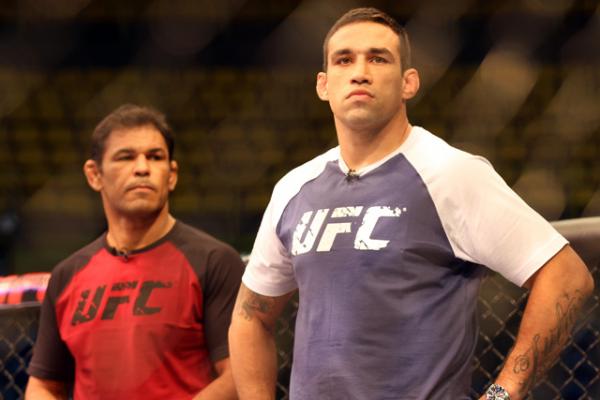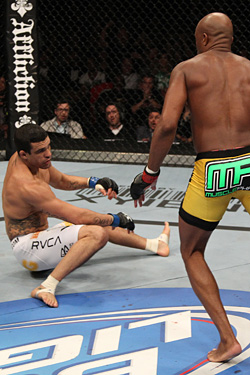MMA’s Newest Epicenter

Antonio Rodrigo Nogueira and Fabricio Werdum on Saturday will
meet for a second time. | Photo: Zuffa LLC/UFC/Getty
In the young history of mixed martial arts, there have been three pronounced popularity explosions of the sport, the first two of which are well known.
In Japan, Pride Fighting Championships rode Kazushi Sakuraba, the Gracies, Wanderlei Silva, Mirko “Cro Cop” Filipovic and Hidehiko Yoshida to stadium sellouts and unprecedented television ratings during its growth period from 2000 to the middle part of the decade. The Ultimate Fighting Championship then capitalized on the creation of “The Ultimate Fighter” in 2005, growing its North American pay-per-view and arena business to record levels in 2006 and beyond. The third popularity explosion has been much quieter, almost inconspicuous, at least to the average MMA fan, but it remains in full force.
Advertisement
As strong as the present looks for MMA in Brazil, the future looks even brighter. Brazil’s economy continues to grow annually at rates much higher than fully developed economies like the United States, Germany and Japan. There will be even more money to spend on MMA. There will also be no problem -- like the one that occurred in Japan -- creating future homegrown heroes to sell to the market. Brazil has star fighters at just about every weight class, including many of the sport’s top prospects.
While there was plenty of potential for MMA to explode in Brazil,
it still needed a trigger. Enter Anderson
Silva and Vitor
Belfort. Their main event at UFC 126 was a perfect matchup for
the Brazilian market: the most famous Brazilian fighter in Belfort
against the best Brazilian fighter in “The Spider.” The fight
attracted unprecedented press and interest in Brazil, with the
event in Las Vegas flooded with Brazilian fans and media.
Perhaps most importantly for the sport, the Belfort-Anderson Silva fight caught the attention of Brazilian television executives. In the fall of 2011, much was made domestically of the announcement of the partnership between the UFC and Fox. However, the UFC signed a deal at that time with a network that had even more power in its native country: Rede Globo. Soon, the UFC was attracting more than 20 million viewers on a regular basis on Brazil’s top television network. “The Ultimate Fighter: Brazil” played the same role that the American version of the show did seven years earlier.

Jed
Jacobsohn/Zuffa LLC/UFC/Getty
Silva-Belfort changed everything in Brazil.
Even when the UFC is not running in Brazil, the country now boasts a strong traveling contingent for every major pay-per-view. Brazilian flags can be seen all over the arena when a Brazilian competitor comes out for a main or co-main event, and Brazilians rival Canadians for the biggest foreign presence at American MMA events. Strikingly, there was a major Brazilian contingent at UFC 159 on April 27 in Newark, N.J., despite no Brazilians fighting in the top three bouts.
With MMA in the midst of a popularity explosion in Brazil, UFC on Fuel TV 10 this Saturday in Fortaleza will likely prove part of an emerging UFC trend. For the first time since the historic Belfort-Anderson Silva pairing, the main event of the show will feature one Brazilian taking on another, as Antonio Rodrigo Nogueira rematches Fabricio Werdum. In addition, the show’s co-headliner also pits Brazilian against Brazilian, with Rafael “Feijao” Cavalcante dueling Thiago Silva. That will make this the first UFC event in history to be headlined by four Brazilian fighters in the top two bouts.
It has been more than two years since an intra-Brazilian rivalry carried a UFC marquee, but it is extremely unlikely that it will be another two years before it happens again. The UFC increasingly caters to the Brazilian market, making it less of a priority to focus on North American competitors. Additionally, the high level of talent coming out of Brazil creates all sorts of intriguing matchups. Perhaps most importantly, intra-Brazilian rivalry is part of the fabric of Brazilian MMA from its early days.
In some countries without great reservoirs of MMA talent, fighters have mostly banded together to improve themselves and challenge the best from other parts of the world. However, in the deepest MMA hotbeds, there is simply too much talent for that to apply. Brazilians were regularly fighting each other in no-holds-barred competition long before they frequently traveled overseas. From Helio Gracie-Valdemar Santana to Rickson Gracie-Hugo Duarte, Brazilians have fought to settle personal issues and prove the supremacy of their styles.
The battle of style-versus-style is particularly important to Brazilian vale tudo competition. Brazilian jiu-jitsu proclaimed its superiority as a fighting art, only to be challenged by luta livre. The later rivalry between Brazilian Top Team and Chute Boxe was defined by the submission grappling prowess of Murilo Bustamente, Mario Sperry and the Nogueira brothers against the dynamic muay thai of Wanderlei Silva and the Rua brothers. It produced some of the most heated action in Pride history, from the high-profile Ricardo Arona-Wanderlei Silva bouts to the criminally forgotten war between Sperry and Murilo “Ninja” Rua at Pride 20. While Brazil’s first love of futebol was heavily nationalist, MMA remained more tribal in nature.
This is not the case with Werdum and Nogueira, as they have similar styles. They are known primarily for their submissions but sport underrated standup and excellent durability. They have more in common as fighters than they have differences. Their fight is not about proving some broader point but rather advancing their position in the sport.
The first time Nogueira and Werdum fought was in 2006 in the Pride open weight grand prix, as each man was looking to capture that prestigious tournament crown. Now they fight to advance their cause in the UFC’s heavyweight division; Werdum, in particular, could put himself in line for a heavyweight title shot. National bragging rights are a nice added bonus for the winner, particularly after being spotlighted on the second season of “The Ultimate Fighter: Brazil.”
With Brazil in the midst of an MMA boom, the stakes are high for Brazil’s premier fighters. Major national sponsorships, big purses and huge fan followings are out there for those who make it to the top, but there is also now more competition for those spots than ever before. Werdum must get past Nogueira and Junior dos Santos just as Belfort must get past Anderson Silva. Competition within the Brazilian MMA scene will only get fiercer from here. One cannot be the world’s best until he is first Brazil’s best.
Related Articles







